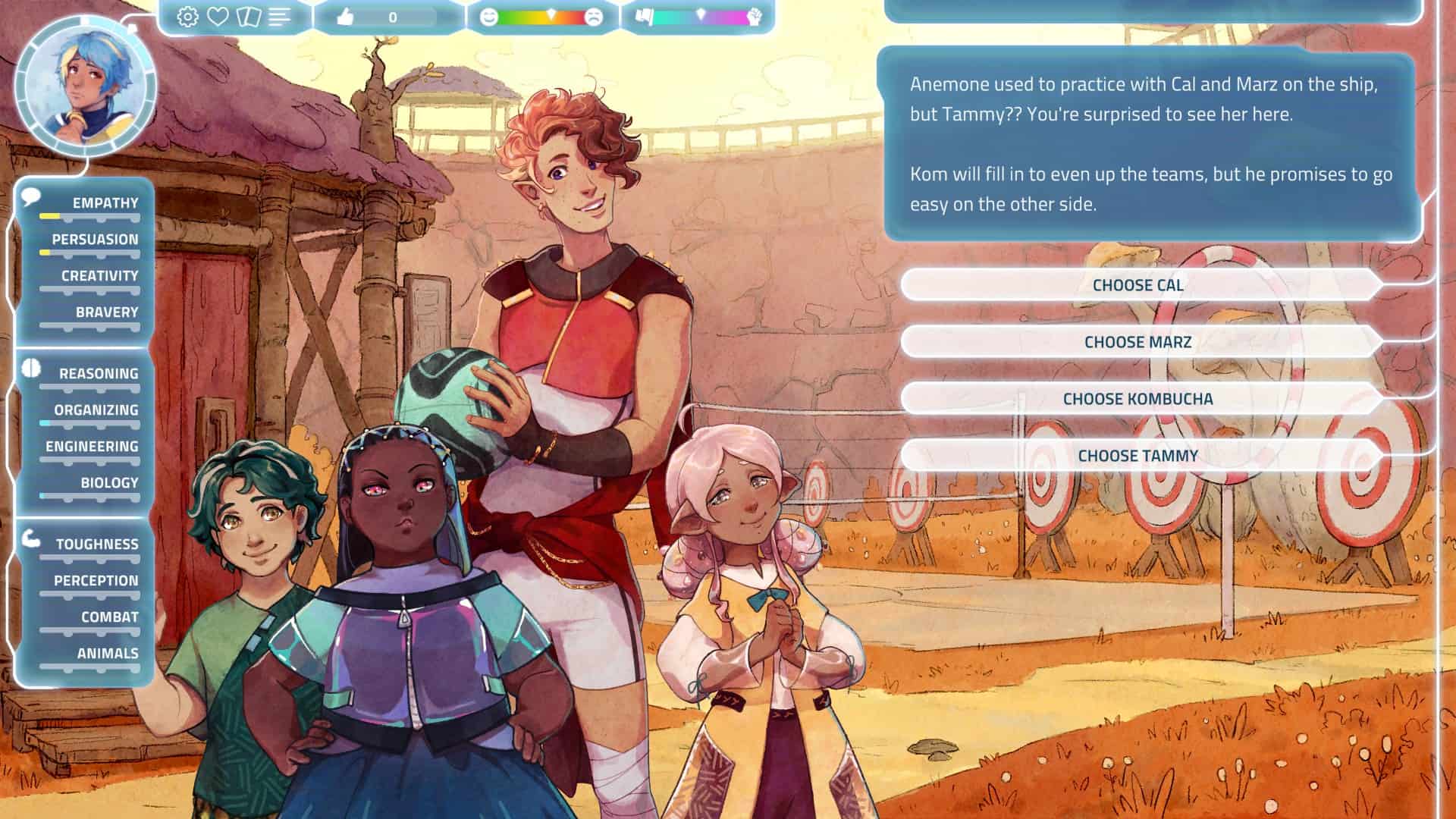Platforms:
PS4, PC, Nintendo Switch, PS5
Released:
August 26, 2022
Publisher:
Finji
Developer:
Northway Games
It has been a particularly good year for narrative-focused video games. First, we got NORCO, a thrilling yet disturbing point-and-click adventure, and then a few months later Citizen Sleeper brought us a thoughtful sci-fi tale with multiple narrative threads. But quite unexpectedly, I Was a Teenage Exocolonist has come out of nowhere to steal the top spot as my personal favourite of them all so far. Set on an alien planet (seemingly) devoid of advanced life, it follows Earth’s first space colony as they try to survive in a new world. The game is a narrative RPG with deck-building mechanics and card battles and skill checks, with a time loop twist that makes multiple playthroughs a joy.
Your player character is ten years old when your spaceship arrives on the alien planet Vertumna, and the game takes place over the next ten years of your life as you try to survive and flourish as a colony. What follows is an emotional RPG narrative about coming of age, making tough choices, environmentalism, and ultimately it’s about human nature. I was thoroughly impressed with how it handled the topic of colonisation — Disillusioned with Earth’s society and feeling persecuted by the prevailing government, the colonists have escaped in a spaceship and want to make a new society somewhere new. But the colonists are not a monolith, nor are they consistent in their values. They are messy, hypocritical human beings, and they act like it. You may grow apart from your childhood friends, or the adults who raised you, if the path you choose disagrees with their ideals.
The game’s colourful design and bright-eyed characters might make you think this would be a game filled with happy farming and making friends, but you would be wrong. Over the course of ten years, your character can experience death, hardship, famine, and various other heavy themes. It never gets too much to handle in my opinion, but the main menu has a very generous list of (spoiler-free) content warnings for anyone who wants to take a quick look before diving in.

Each year is separated into 13 months, and each month you must choose an activity to occupy yourself with. This activity might be studying a skill, helping adults with chores, or exploring the alien wilderness, with more options becoming available as you get older and increase your skills. This is the main gameplay loop, and it’s fun and easy to get used to. It’s during these activities that plot-important events will reveal themselves or progress, so it’s a good idea to do a little bit of everything lest you miss out. There are hundreds of little scenes to find in these activities that deepen your connection to the other characters, the colony, and the planet. Every scene feels like a natural progression from the last, and feels very genuine.

While most monthly activities are accomplished with a simple card battle, surveying is the exception. In these sequences, you can explore various environments of the planet while encountering events, some scripted and some randomised. This is the only time you’ll really get a good look at the planet Vertumna, which is a bit of a shame since so much effort has been put into making it look beautiful and feel viable as a real ecosystem.
Diversity front and centre
Teenage Exocolonist has the most diverse cast and character options I’ve ever encountered in an RPG, which is fantastic to see. Among the kids and adults of the colony, you’ll find different gender identities, as well as many different body and skin types.
You can choose your character’s pronouns, including non-binary ones, and this choice does not dictate what your character looks like. How masculine, androgynous, or feminine your character will look in their later years is a separate choice. And even this does not determine what ‘bits’ you’ve got: the game tastefully asks you what aspects of puberty will be relevant to you when you hit your 13th year, and the only thing it changes is various flavour texts. You can even choose to avoid the topic altogether.

If you choose non-binary pronouns, you’ll be presented with further options to choose from. You can use They/Them in either its singular or plural form, or you can choose custom pronouns. You can then choose the contexts in which various pronouns appear, making it a simple matter to play as someone with multiple pronouns like She/They or He/Xe. You can even get replace all gendered phrases and words, like ‘Auntie/Uncle’ or ‘Boyfriend/Girlfriend’, with neutral equivalents. It’s an amazing touch for non-binary gamers who don’t often see their preferred pronouns in games!
Romance options are open regardless of your gender. All of your romanceable peers grow up to be stunningly beautiful of course, but not all of them are conventionally so. And I absolutely love the awkward pimply phase they go through from ages 14-16. And yes, don’t worry. You can kiss an alien.
During your chosen monthly activity, as well as anytime the story calls for it, you’ll be presented with a card battle. To succeed, you need to assemble a strong hand of ‘Memory Cards’. These cards represent your character’s memories and life experiences, and you get awarded new ones periodically throughout the story. Each card’s colour indicates its suit (physical, mental, and social) and its number indicates its value. Your goal is to create a strong hand in a similar manner to Poker, with extra points awarded for straights, flushes, and multiples of a kind. If your hand value meets the target goal, you succeed. What’s in your deck of Memory cards — which suit and how strong they are — depends on what monthly activities you’ve focused on and which narrative routes you’ve completed.
All I can say is, what an inspired idea for a coming-of-age story! Every card is lovingly illustrated and labelled with the memory, which is always a reference to something you’ve actually experienced that playthrough. It really feels like your character is drawing on their own experiences to overcome each new challenge, making the card battles feel more immersive than they would otherwise.
It’s a system that is easy to learn, with the game easing you into it slowly but surely. Late-game cards often have extra effects that will help switch things up and form powerful combos. The number of possible cards in the game is massive, and if the in-game gallery is to believe, I didn’t even find half of them over two playthroughs. There are a lot of options to help you win the hand if you’re struggling, like items that boost card values. It can even feel a bit too easy after a while, but there is an optional hard mode if you want a greater challenge.

“What an inspired idea
for a coming-of-age
story!”
You won’t be able to discover everything in the game within one playthrough. If you’re a fan of branching narratives like me, that thought will delight you – and Teenage Exocolonist makes subsequent playthroughs great fun by having your character mysteriously remember bits and pieces of their ‘past life’. Using your future knowledge, you can avoid tragedies before they happen, as well as simplify and speed up quests that originally took you months or even years. Your character’s visions of other timelines are woven into the plot, so it doesn’t break any emersion when they happen.
Those who don’t have the time nor inclination to play a game more than once won’t get the full benefit of what the game offers, though. Your first playthrough will in all likelihood not end very satisfyingly (unless you’ve been extraordinarily lucky), because the game wants you to play it more than once.
I am reminded of Undertale, which is another game that assumes you will play it more than once to get a better ending. This enhances the experience for those players who do, but it comes at the expense of anyone who just doesn’t want to play the same game over again. This is purely a matter of taste, but it has to be said that this game has many, many, many more endings than Undertale. If that excites you, then you, like me, will adore the hell out of Teenage Exocolonist. If that thought only makes you tired, then while it still gets my recommendation, it might not be as meaningful to you.
9
Amazing
Positive:
- Emotionally touching narrative with a mystery twist
- Easy-to learn card battles that don't distract from the story
- Beautiful character and background illustrations
- Fully customisable pronouns!
Negative:
- You need to do multiple playthroughs to get the most of this game
Not often do we see a narrative RPG with so much squeezed inside a relatively small package. I Was a Teenage Exocolonist will leave you thinking, laughing, crying, and even blushing. With beautiful character illustrations and a story that feels genuine from start to finish, this is a must-play for anyone who enjoys narrative games. Though one playthrough will run you around 5-10 hours, the things you missed will have you coming back for one more playthrough every time.











